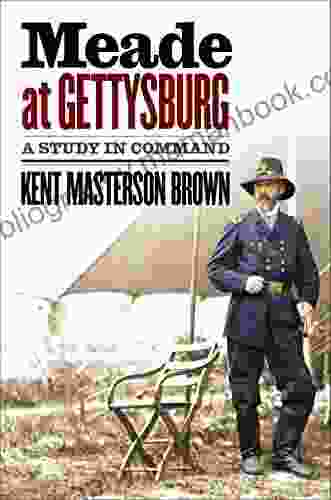Study In Command: Civil War America

The American Civil War was a complex and bloody conflict that tested the limits of both the Union and Confederate armies. The outcome of the war rested heavily on the shoulders of the generals who commanded these armies, and their ability to lead their troops to victory.
Challenges Faced by Generals
The generals who fought in the Civil War faced a number of challenges, including:
4.8 out of 5
| Language | : | English |
| File size | : | 31859 KB |
| Text-to-Speech | : | Enabled |
| Enhanced typesetting | : | Enabled |
| X-Ray | : | Enabled |
| Word Wise | : | Enabled |
| Print length | : | 670 pages |
| Screen Reader | : | Supported |
- The sheer size of the armies. The Union and Confederate armies were the largest ever assembled in North America up to that point, and they were often spread out over vast distances. This made it difficult for generals to communicate with their troops and to coordinate their movements.
- The lack of modern technology. Generals in the Civil War did not have access to radios or telephones, so they had to rely on messengers and couriers to communicate with their troops. This often led to delays and confusion.
- The terrain. The Civil War was fought over a wide variety of terrain, from the rolling hills of Virginia to the swamps of Louisiana. This made it difficult for generals to plan and execute their campaigns.
- The weather. The Civil War was fought in all seasons, and the weather often played a major role in the outcome of battles. Generals had to be prepared to fight in extreme heat, cold, rain, and snow.
Strategies for Success
Despite the challenges they faced, the generals who fought in the Civil War developed a number of strategies for success, including:
- Concentration of force. Generals often concentrated their forces in order to achieve a breakthrough or to defend a key position. This strategy was used effectively by both Union and Confederate generals.
- Maneuver. Generals often maneuvered their troops in order to gain an advantage over their opponents. This strategy was used effectively by Union generals such as Ulysses S. Grant and Confederate generals such as Robert E. Lee.
- Siege warfare. Generals often besieged enemy cities and fortifications in order to force them to surrender. This strategy was used effectively by both Union and Confederate generals.
- Logistics. Generals had to ensure that their troops were supplied with food, ammunition, and other supplies. This was a complex and challenging task, especially in the vast and unforgiving terrain of the Civil War.
The Role of Leadership
In addition to developing sound strategies, the generals who fought in the Civil War also needed to be strong leaders. They had to be able to inspire their troops, motivate them to fight, and make difficult decisions in the heat of battle.
Some of the most successful generals in the Civil War, such as Grant and Lee, were known for their strong leadership skills. They were able to inspire their troops to follow them into battle, even in the face of overwhelming odds. They were also able to make difficult decisions in the heat of battle, and they were always willing to take risks in order to achieve victory.
The study of command during the American Civil War is a complex and fascinating subject. The generals who fought in this war faced a number of challenges, but they also developed a number of strategies for success. In addition to developing sound strategies, the generals who fought in the Civil War also needed to be strong leaders. They had to be able to inspire their troops, motivate them to fight, and make difficult decisions in the heat of battle.
The study of command during the Civil War can teach us a great deal about leadership, strategy, and the nature of war itself. It is a subject that continues to be studied and debated by historians and military strategists today.

4.8 out of 5
| Language | : | English |
| File size | : | 31859 KB |
| Text-to-Speech | : | Enabled |
| Enhanced typesetting | : | Enabled |
| X-Ray | : | Enabled |
| Word Wise | : | Enabled |
| Print length | : | 670 pages |
| Screen Reader | : | Supported |
Do you want to contribute by writing guest posts on this blog?
Please contact us and send us a resume of previous articles that you have written.
 Top Book
Top Book Novel
Novel Fiction
Fiction Nonfiction
Nonfiction Literature
Literature Paperback
Paperback Hardcover
Hardcover E-book
E-book Audiobook
Audiobook Bestseller
Bestseller Classic
Classic Mystery
Mystery Thriller
Thriller Romance
Romance Fantasy
Fantasy Science Fiction
Science Fiction Biography
Biography Memoir
Memoir Autobiography
Autobiography Poetry
Poetry Drama
Drama Historical Fiction
Historical Fiction Self-help
Self-help Young Adult
Young Adult Childrens Books
Childrens Books Graphic Novel
Graphic Novel Anthology
Anthology Series
Series Encyclopedia
Encyclopedia Reference
Reference Guidebook
Guidebook Textbook
Textbook Workbook
Workbook Journal
Journal Diary
Diary Manuscript
Manuscript Folio
Folio Pulp Fiction
Pulp Fiction Short Stories
Short Stories Fairy Tales
Fairy Tales Fables
Fables Mythology
Mythology Philosophy
Philosophy Religion
Religion Spirituality
Spirituality Essays
Essays Critique
Critique Commentary
Commentary Glossary
Glossary Bibliography
Bibliography Index
Index Table of Contents
Table of Contents Preface
Preface Introduction
Introduction Foreword
Foreword Afterword
Afterword Appendices
Appendices Annotations
Annotations Footnotes
Footnotes Epilogue
Epilogue Prologue
Prologue Michael J Behe
Michael J Behe Demelza Carlton
Demelza Carlton Aashish Gupta
Aashish Gupta Larry Slawson
Larry Slawson Morag Martin
Morag Martin Lisa Long
Lisa Long Ian Mccurrach
Ian Mccurrach Saryu Bathia
Saryu Bathia John Buchan
John Buchan Otm Author Services
Otm Author Services Ann Leckie
Ann Leckie Edward S Ebert
Edward S Ebert Leo Schneeschuh
Leo Schneeschuh Clarisse A Jordan
Clarisse A Jordan Allene R Lowrey
Allene R Lowrey Debora Sirbu
Debora Sirbu Michelle Zauner
Michelle Zauner Concha Delgado Gaitan
Concha Delgado Gaitan Jeffry A Frieden
Jeffry A Frieden Elizabeth Shane
Elizabeth Shane
Light bulbAdvertise smarter! Our strategic ad space ensures maximum exposure. Reserve your spot today!

 Houston PowellDr. Stone Vol. 14: Medusa's True Face - An Enchanting Journey into the World...
Houston PowellDr. Stone Vol. 14: Medusa's True Face - An Enchanting Journey into the World...
 Victor TurnerTur An Elsker Saga Prequel Novella: Unveil the Enchanting Prelude to an Epic...
Victor TurnerTur An Elsker Saga Prequel Novella: Unveil the Enchanting Prelude to an Epic... Ismael HayesFollow ·2k
Ismael HayesFollow ·2k Mike HayesFollow ·14.9k
Mike HayesFollow ·14.9k Art MitchellFollow ·5.1k
Art MitchellFollow ·5.1k Dillon HayesFollow ·5k
Dillon HayesFollow ·5k Harvey HughesFollow ·12.3k
Harvey HughesFollow ·12.3k Harvey BellFollow ·6.1k
Harvey BellFollow ·6.1k Robert BrowningFollow ·4.4k
Robert BrowningFollow ·4.4k Ray BlairFollow ·10.9k
Ray BlairFollow ·10.9k

 Patrick Rothfuss
Patrick RothfussHow to Make a Million Dollars: No Secrets
Making a million dollars...

 Robert Heinlein
Robert HeinleinResponse to Intervention, Second Edition: RTI in Practice
A Comprehensive Resource for Educators and...

 Timothy Ward
Timothy WardUnravel the Gripping Assassination Thriller Bursting with...
Prepare yourself for a...
4.8 out of 5
| Language | : | English |
| File size | : | 31859 KB |
| Text-to-Speech | : | Enabled |
| Enhanced typesetting | : | Enabled |
| X-Ray | : | Enabled |
| Word Wise | : | Enabled |
| Print length | : | 670 pages |
| Screen Reader | : | Supported |














